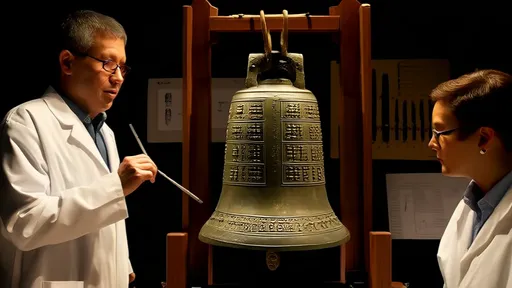The ancient chime bells of China’s Warring States period (475–221 BCE) have long fascinated historians, musicians, and archaeologists alike. These magnificent bronze artifacts, known as bianzhong, were not merely musical instruments but symbols of power, ritual, and technological sophistication. Recent breakthroughs in acoustic archaeology have allowed researchers to reconstruct the dual-tone phenomenon of these bells, revealing a level of acoustic engineering that was millennia ahead of its time. The process of recreating their sounds has opened a window into the sonic world of ancient China, offering insights into the cultural and scientific achievements of a civilization lost to time.
The bianzhong were designed to produce two distinct tones when struck at different points—a feature that baffled modern scholars for decades. How could craftsmen from over two thousand years ago achieve such precision without the aid of modern acoustical science? Through a combination of 3D scanning, spectral analysis, and metallurgical studies, researchers have begun to decode the secrets behind these ancient instruments. The bells were cast using an intricate process that accounted for subtle variations in thickness and shape, allowing them to vibrate in a way that produced clear, harmonious dual tones. This discovery has reshaped our understanding of early Chinese metallurgy and musical theory.
One of the most remarkable aspects of this research is how it bridges the gap between past and present. By using advanced audio software, archaeologists and musicians have been able to simulate the exact sounds these bells would have produced in their original context. The reconstructed tones are not just scientific curiosities—they are echoes of ceremonies, courtly performances, and perhaps even battles that once defined the Warring States era. The precision of the bianzhong suggests that their creators possessed an intuitive grasp of harmonic principles that would not be formally documented until much later in history.
The cultural significance of these findings cannot be overstated. In ancient China, music was deeply intertwined with cosmology, politics, and philosophy. The bianzhong were not merely instruments but tools for maintaining harmony between heaven and earth, a concept central to Confucian and Daoist thought. The ability to reproduce their sounds allows modern audiences to experience a fragment of this worldview, offering a rare auditory connection to a civilization that valued sonic perfection as a reflection of cosmic order.
Yet, the research has also raised new questions. Why did this technology seemingly disappear after the Warring States period? Were there other instruments with similar capabilities that have been lost to time? Some scholars speculate that the fall of the Zhou dynasty and the subsequent rise of the Qin may have disrupted the transmission of this knowledge. Others suggest that the complexity of the bianzhong made them too costly or difficult to reproduce in later eras. Whatever the reason, the rediscovery of their dual-tone mechanism stands as a testament to the ingenuity of ancient Chinese artisans.
Today, museums and research institutions are collaborating to bring these reconstructed sounds to the public. Interactive exhibits allow visitors to "play" virtual replicas of the bells, while concert performances featuring reproduced bianzhong offer a glimpse into the grandeur of ancient Chinese music. These efforts are not just about preserving history—they are about reviving it, allowing the past to resonate in the present. As acoustic archaeology continues to advance, who knows what other lost sounds of antiquity may yet be recovered?
The story of the Warring States period bianzhong is more than a tale of musical innovation. It is a reminder of how much we still have to learn from the ancient world. The interplay of art, science, and spirituality in these bells challenges modern assumptions about technological progress. Perhaps, in listening to their reconstructed tones, we are not just hearing the past but also finding new ways to understand the enduring human quest for harmony—both in sound and in society.

By /Aug 5, 2025

By /Aug 5, 2025

By /Aug 5, 2025

By /Aug 5, 2025

By /Aug 5, 2025

By /Aug 5, 2025

By /Aug 5, 2025

By /Aug 5, 2025

By /Aug 5, 2025

By /Aug 5, 2025

By /Aug 5, 2025

By /Aug 5, 2025

By /Aug 5, 2025

By /Aug 5, 2025

By /Aug 5, 2025

By /Aug 5, 2025

By /Aug 5, 2025

By /Aug 5, 2025

By /Aug 5, 2025

By /Aug 5, 2025